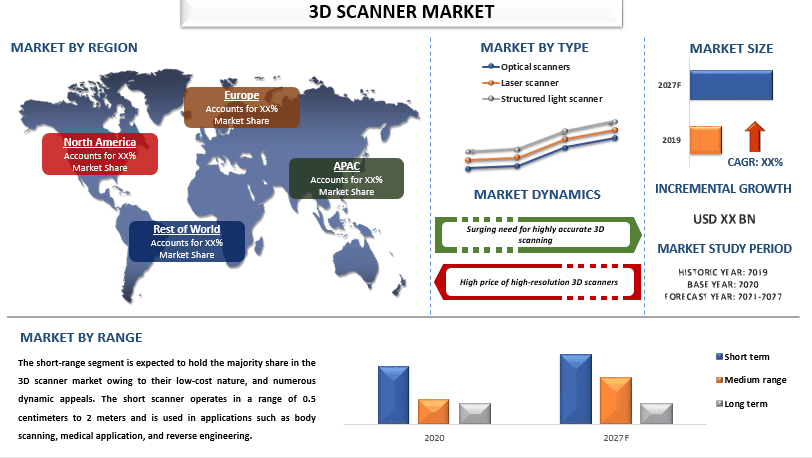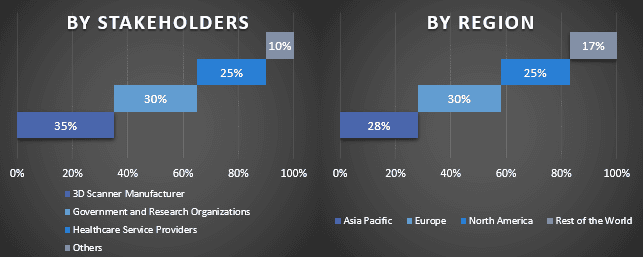- Home
- About Us
- Industry
- Services
- Reading
- Contact Us
3D Scanner Market: Current Analysis and Forecast (2021-2027)
Emphasis on Type (Optical scanner, Laser scanner, Structured light scanner), Range (Short range, Medium range, Long-range); Application (Entertainment & Media, Aerospace & Defense, Healthcare, Civil And Architecture, Industrial Manufacturing, Others); Region/ Countries

The 3D Scanner Market is expected to grow at a CAGR of 12% during the forecast period. The market is driven by increasing R&D spending and advancements in technology. Furthermore, the emergence of structured light technology is also expected to drive the growth of the 3D scanner market. In addition, 3D scanner technology saves time, money, and labor and improves output quality throughout the manufacturing process. Basically, a 3D scanner uses a laser, light, or X-ray to capture the dimensions of a real object and create a point cloud. Point clouds are used to create 3D models of scanned objects using the software. In addition, 3D printer scanner technology is on the rise in aerospace, military, automotive, healthcare, and other areas.
Insights Presented in the Report
“Amongst type, the laser scanner segment is expected to witness the highest CAGR during the forecast period”
Based on type, the market is segmented into optical scanners, laser scanners, and structured light scanners. The laser scanner segment is expected to hold the majority of the 3D scanner market owing to its ability to capture millions of data points in seconds. These scanners use laser light to capture the physical data in the environment. Laser scanners are generally ideal for scanning sensitive environments and objects.
“Amongst range, the short-range segment is expected to witness the highest CAGR during the forecast period”
Based on the range, the market is segmented into short-range, medium-range, and long-range. The short-range segment is expected to hold the majority of the 3D scanner market due to the benefits such as their low-cost, and numerous dynamic appeals. The short scanner operates in a range of 0.5 centimeters to 2 meters and is used in applications such as body scanning, medical application, and reverse engineering.
“Amongst offering, the hardware segment is expected to witness the highest CAGR during the forecast period”
Based on offering, the market is segmented into hardware, software, and services. The hardware segment is expected to dominate the 3D scanner market during the forecast period. The advancements and adoption of new 3D scanner technology are expected to drive the market during the forecast period.
“Amongst application, the healthcare segment is expected to witness the highest CAGR during the forecast period”
Based on application, the market is segmented into entertainment & media, aerospace & defense, healthcare, civil & architecture, industrial manufacturing, and others. The healthcare segment is expected to hold the majority of the 3D scanner market during the forecast period. Custom modeling of prostheses using 3D scanning and printing in the healthcare sector continues to drive the growth of 3D technology in the dynamic life sciences industry. 3D scanning technology is used to display an expanded 3D model of the human body to assist in the anatomy of the human body and to display a live 3D projection of the human body to assist in manipulation.
“Asia Pacific to witness significant growth during the forecast period”
Asia pacific holds the majority of the 3D scanning market owing to the presence of prime players in the region. Countries in APAC are involved in the manufacturing of defense aircraft, thereby leading to an increase in demand for 3D scanners for inspection applications in the aerospace and defense industry of the region. Growing population, flourishing economies (developed and developing), and ongoing government initiatives to promote industrial growth have made APAC an ideal destination for establishing the production units of various industries, including semiconductors, electronics, and automotive. The demand for automobiles in APAC is expected to grow in the coming years. This, in turn, will result in an increased production of vehicles in the region, thereby contributing to the demand for 3D scanners.
Reasons to buy this report:
- The study includes market sizing and forecasting analysis validated by authenticated key industry experts.
- The report presents a quick review of overall industry performance at one glance.
- The report covers an in-depth analysis of prominent industry peers with a primary focus on key business financials, product portfolios, expansion strategies, and recent developments.
- Detailed examination of drivers, restraints, key trends, and opportunities prevailing in the industry.
- The study comprehensively covers the market across different segments.
- Deep dive regional level analysis of the industry.
Customization Options:
The global 3D scanner market can further be customized as per the requirement or any other market segment. Besides this, UMI understands that you may have your own business needs, hence feel free to connect with us to get a report that completely suits your requirements.
Table of Content
Analyzing the historical market, estimating the current market, and forecasting the future market of the global 3D scanner market were the three major steps undertaken to create and analyze the adoption of the 3D scanner in major regions globally. Exhaustive secondary research was conducted to collect the historical market numbers and estimate the current market size. Secondly, to validate these insights, numerous findings and assumptions were taken into consideration. Moreover, exhaustive primary interviews were also conducted, with industry experts across the value chain of the global 3D scanner market. Post assumption and validation of market numbers through primary interviews, we employed a top-down/bottom-up approach to forecasting the complete market size. Thereafter, market breakdown and data triangulation methods were adopted to estimate and analyze the market size of segments and sub-segments of the industry pertains to. Detailed methodology is explained below:
Analysis of Historical Market Size
Step 1: In-Depth Study of Secondary Sources:
Detail secondary study was conducted to obtain the historical market size of the 3D scanner market through company internal sources such as annual reports & financial statements, performance presentations, press releases, etc., and external sources including journals, news & articles, government publications, competitor publications, sector reports, third-party database, and other credible publications.
Step 2: Market Segmentation:
After obtaining the historical market size of the 3D scanner market, we conducted a detailed secondary analysis to gather historical market insights and share for different segments & sub-segments for major regions. Major segments are included in the report as a type, range, offering, and application. Further country-level analyses were conducted to evaluate the overall adoption of testing models in that region.
Step 3: Factor Analysis:
After acquiring the historical market size of different segments and sub-segments, we conducted a detailed factor analysis to estimate the current market size of the 3D scanner market. Further, we conducted factor analysis using dependent and independent variables such as type, range, offering, and application of 3D scanner. A thorough analysis was conducted for demand and supply-side scenarios considering top partnerships, mergers and acquisitions, business expansion, and product launches in the 3D scanner market sector across the globe.
Current Market Size Estimate & Forecast
Current Market Sizing: Based on actionable insights from the above 3 steps, we arrived at the current market size, key players in the global 3D scanner market, and market shares of the segments. All the required percentage shares split, and market breakdowns were determined using the above-mentioned secondary approach and were verified through primary interviews.
Estimation & Forecasting: For market estimation and forecast, weights were assigned to different factors including drivers & trends, restraints, and opportunities available for the stakeholders. After analyzing these factors, relevant forecasting techniques i.e., top-down/bottom-up approach were applied to arrive at the market forecast about 2027 for different segments and sub-segments across the major markets globally. The research methodology adopted to estimate the market size encompasses:
- The industry’s market size, in terms of revenue (USD) and the adoption rate of the 3D scanner market across the major markets domestically
- All percentage shares, splits, and breakdowns of market segments and sub-segments
- Key players in the global 3D scanner market in terms of solutions offered. Also, the growth strategies adopted by these players to compete in the fast-growing market
Market Size and Share Validation
Primary Research: In-depth interviews were conducted with the Key Opinion Leaders (KOLs) including Top Level Executives (CXO/VPs, Sales Head, Marketing Head, Operational Head, and Regional Head, Country Head, etc.) across major regions. Primary research findings were then summarized, and statistical analysis was performed to prove the stated hypothesis. Inputs from primary research were consolidated with secondary findings, hence turning information into actionable insights.
Split of Primary Participants in Different Regions

Market Engineering
The data triangulation technique was employed to complete the overall market estimation and to arrive at precise statistical numbers for each segment and sub-segment of the global 3D scanner market. Data was split into several segments & sub-segments post studying various parameters and trends in the areas of type, range, offering, and application in the global 3D scanner market.
The main objective of the global 3D scanner market study
The current & future market trends of the global 3D scanner market were pinpointed in the study. Investors can gain strategic insights to base their discretion for investments on the qualitative and quantitative analysis performed in the study. Current and future market trends determined the overall attractiveness of the market at a regional level, providing a platform for the industrial participant to exploit the untapped market to benefit from a first-mover advantage. Other quantitative goals of the studies include:
- Analyze the current and forecast market size of the 3D scanner market in terms of value (USD). Also, analyze the current and forecast market size of different segments and sub-segments
- Segments in the study include areas of type, range, offering, and application.
- Define and analysis of the regulatory framework for the 3D scanner market industry.
- Analyze the value chain involved with the presence of various intermediaries, along with analyzing customer and competitor behaviors of the industry.
- Analyze the current and forecast market size of the 3D scanner market for the major region.
- Major countries of regions studied in the report include Asia Pacific, Europe, North America, and the Rest of the world.
- Company profiles of the 3D scanner market and the growth strategies adopted by the market players to sustain in the fast-growing market
- Deep dive regional level analysis of the industry
Related Reports
Customers who bought this item also bought










